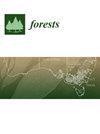利用综合随机森林和最小二乘法机器学习模式估算亚热带树种生物量的垂直分布
IF 2.4
2区 农林科学
Q1 FORESTRY
引用次数: 0
摘要
准确量化森林生物量(FB)是评估陆地生态系统碳预算的关键。利用遥感反演技术估算森林生物量近来已成为一种研究趋势。然而,垂直尺度分析方法的局限性和森林生物量分层的非线性分布导致 FB 估算存在很大的不确定性。本研究考虑了森林垂直分层的生物量特征,基于随机森林和最小二乘法(RF-LS)模型的集成,提高了森林生物量预测的潜力。结果表明,与传统的生物量估算方法相比,FB检索的总体R2提高了12.01%,均方根误差(RMSE)降低了7.50 Mg-hm-2。我们建立的 RF-LS 模型在 FB 反演和模拟评估中表现出更好的性能。林冠高度、土壤有机质含量和红边叶绿素植被指数等指标对FB估算的影响较大。在使用 RF-LS 集成模型进行 FB 估计时,这些指标可作为考虑的重点。总之,本研究提供了一种通过地上林分精细分层绘制和评价 FB 的优化方法,并揭示了 FB 反演和 RF-LS 模型适用性的重要指标。研究结果可作为亚热带森林生物量参数精确反演和碳储量估算的参考。本文章由计算机程序翻译,如有差异,请以英文原文为准。
Estimating the Vertical Distribution of Biomass in Subtropical Tree Species Using an Integrated Random Forest and Least Squares Machine Learning Mode
Accurate quantification of forest biomass (FB) is the key to assessing the carbon budget of terrestrial ecosystems. Using remote sensing to apply inversion techniques to the estimation of FBs has recently become a research trend. However, the limitations of vertical scale analysis methods and the nonlinear distribution of forest biomass stratification have led to significant uncertainties in FB estimation. In this study, the biomass characteristics of forest vertical stratification were considered, and based on the integration of random forest and least squares (RF-LS) models, the FB prediction potential improved. The results indicated that compared with traditional biomass estimation methods, the overall R2 of FB retrieval increased by 12.01%, and the root mean square error (RMSE) decreased by 7.50 Mg·hm−2. The RF-LS model we established exhibited better performance in FB inversion and simulation assessments. The indicators of forest canopy height, soil organic matter content, and red-edge chlorophyll vegetation index had greater impacts on FB estimation. These indexes could be the focus of consideration in FB estimation using the integrated RF-LS model. Overall, this study provided an optimization method to map and evaluate FB by fine stratification of above-ground forest and reveals important indicators for FB inversion and the applicability of the RF-LS model. The results could be used as a reference for the accurate inversion of subtropical forest biomass parameters and estimation of carbon storage.
求助全文
通过发布文献求助,成功后即可免费获取论文全文。
去求助
来源期刊

Forests
FORESTRY-
CiteScore
4.40
自引率
17.20%
发文量
1823
审稿时长
19.02 days
期刊介绍:
Forests (ISSN 1999-4907) is an international and cross-disciplinary scholarly journal of forestry and forest ecology. It publishes research papers, short communications and review papers. There is no restriction on the length of the papers. Our aim is to encourage scientists to publish their experimental and theoretical research in as much detail as possible. Full experimental and/or methodical details must be provided for research articles.
 求助内容:
求助内容: 应助结果提醒方式:
应助结果提醒方式:


